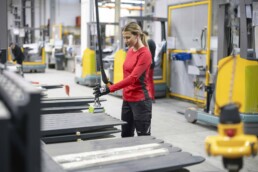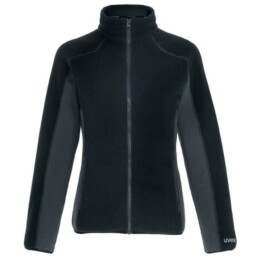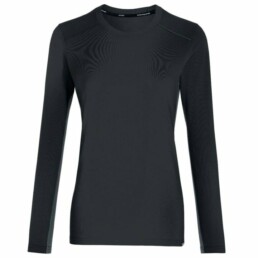Personal protective equipment (PPE) is an indispensable part of the working day in many sectors, and employers and employees alike are often legally obliged to wear it. This includes helmets in the construction trade, chemical protection gloves in the medical sector and fireproof protective clothing for firefighters. Many of these fields of work are still largely dominated by men – so PPE is predominantly tailored to men’s needs. For women who have to make do with this PPE, this often means sacrificing wearer comfort and in the most serious cases can represent a health and safety hazard. In this blog post, we will look at where these problems stem from and how we can solve them.
Why is PPE for women important?
The protection offered by personal protective equipment depends to a significant degree on how well it fits. Clothing should not be too loose and cuffs should fit perfectly on the arms and legs to ensure that no harmful substances or gases can get inside the garment. At the same time, however, protective clothing should not be too tight in order to ensure that there is an insulating layer of air between the material and the wearer’s body. Only an optimal fit can provide optimal safety.
However, when standard PPE is used, it rarely fits women well as it’s designed for the male form. That might work for some women, but for many it won’t. Women are generally smaller than men and have narrower shoulders and waists and wider hips and thighs. As a result, protective clothing is often too long or broad for women. This has an impact on wearer comfort as well as ergonomics. In the worst-case scenario, a poor fit can even be dangerous: trouser legs or sleeves that are too wide can get caught on branches, doorknobs or similar, impeding freedom of movement or damaging the clothing.
Safety shoes also frequently fit poorly. Although they are often supplied in smaller sizes for women, they are generally not adapted for women’s narrower feet. As a result, they are frequently too wide, leading to poor grip in the shoe and the formation of blisters. When worn for a long time, this can negatively affect foot health. If no suitable women’s PPE is available, female employees might even decide to do without protective equipment such as helmets or safety spectacles because of the poor fit of these items impeding their work. In these situations, too, the consequences can be devastating.

Equal rights at work
As these examples show, it’s critical to invest in women’s PPE in order to optimally protect female staff during their daily work. In reality, however, there are only a handful of manufacturers that produce special protective clothing for women. In addition, companies and organisations don’t always invest in these items that are tailored to women. But where does this attitude come from?
Women in “men’s jobs”
Typically, careers in which protective clothing needs to be worn on a daily basis are seen as “men’s jobs”. This includes various industrial sectors such as the automotive or metalworking industries, warehouse logistics, construction work, vehicle recovery or work in the fire brigade. Although the ratio of men to women remains high in these fields, women have always worked in them too – and their numbers are increasing. According to Statista, the proportion of women in the construction industry rose to around 13% in 2023. It therefore makes sense to invest in protective clothing that is specially designed for women.

The profitability of women’s PPE
Women’s clothing is a very profitable sector – that much is clear from the fashion industry, which has a very broad female target group and is worth an estimated two trillion US dollars. There are also many jobs that are typically seen as “female” and that require specific clothing: carers, specialist medical and veterinary assistants, nurses, chefs etc. use dedicated PPE such as safety gloves to maintain the required hygiene in the workplace and protect themselves.
According to Fortune Business Insights, in 2022 the global market for PPE was worth some 80.38 billion US dollars. This figure is expected to rise to 110.85 billion US dollars by 2029. Given these numbers, it seems wise for companies to invest more of their profits into developing PPE specifically for women.
Workwear for women – what are the possible solutions?
If your jacket sleeves or trouser legs are too long or too wide, it’s tempting to adjust the fit yourself. However, it’s strongly advised not to attempt DIY clothing alterations. These days, protective equipment is made using the latest high-tech materials. Cutting into, stitching or otherwise altering your PPE may impair the protective effect of these materials. As a result, any quality guarantees issued by the original manufacturer are no longer valid, and there will be a risk of injury.
The best way forward is clear: PPE manufacturers must pay more attention to analysing and mapping out the specific requirements of women in the world of work and then take these requirements into consideration when designing protective equipment.
Workwear and PPE for women from uvex
At uvex, we have been working extensively on developing workwear and PPE specifically tailored to women’s requirements since 2016. The uvex mission throughout all our departments is “protecting people”. It therefore goes without saying that we are committed to increasing inclusion in the PPE sector and ensuring that everybody can go about their work with the best possible protective equipment.
The development of products explicitly intended for women is a key part of that. The focus here is on wearer acceptance, with cut and design adapted to fit women’s bodies. Tops are designed with narrower shoulders and more defined waists, and women’s curvier hips are taken into consideration. When it comes to trousers, we offer various fits including regular and slim fits.
It’s important that women feel good in their workwear, and that’s why we also focus on women’s requirements when designing these pieces. For example, with trousers we use panel seams to ensure that the waistband appears lower. The trousers actually sit much higher and are therefore more comfortable, but the appearance of a lower waistband provides a more fashionable look. The side seams and pockets are also placed further forwards, creating a slimmer silhouette. uvex workwear for women is carefully tailored to the requirements of female PPE wearers.
Safety shoes for women
Safety shoes for women are one of the flagship products of the uvex safety range. We take the expertise we have developed over decades and apply it to developing safety shoes that perfectly meet the requirements of female wearers. Women’s feet are generally smaller and narrower than men’s feet, while their ankle and calf circumferences are larger. uvex uses special lasts to produce safety shoes, safety sandals and safety boots that are suited to the anatomy of women’s feet and offer an optimal fit. Optional insoles to individually adjust shoe width perfectly round off the range. In addition to the various colourways available in our current models, uvex also designs shoes that combine safety and style without sacrificing either.
Women’s workwear: trousers and tops
You can also buy various items of women’s workwear, protective clothing and work uniforms from uvex. From t-shirts and trousers to jackets, all are carefully tailored to fit women’s bodies. Discover our new range suXXeed craft, which offers workwear for all fields of work – for women and men.
Discover PPE for women at uvex
At uvex, you’ll find a wide range of professional, stylish and safe PPE for women – designed and developed by our experts. As well as workwear and safety shoes, uvex also offers products in other PPE categories that are also tailored to the female form: for example, the smallest safety gloves start in size 5, while the uvex portfolio includes safety spectacles and respirators for narrow faces. Women have the right to suitable protective equipment that will protect them from potential hazards in their daily work.


